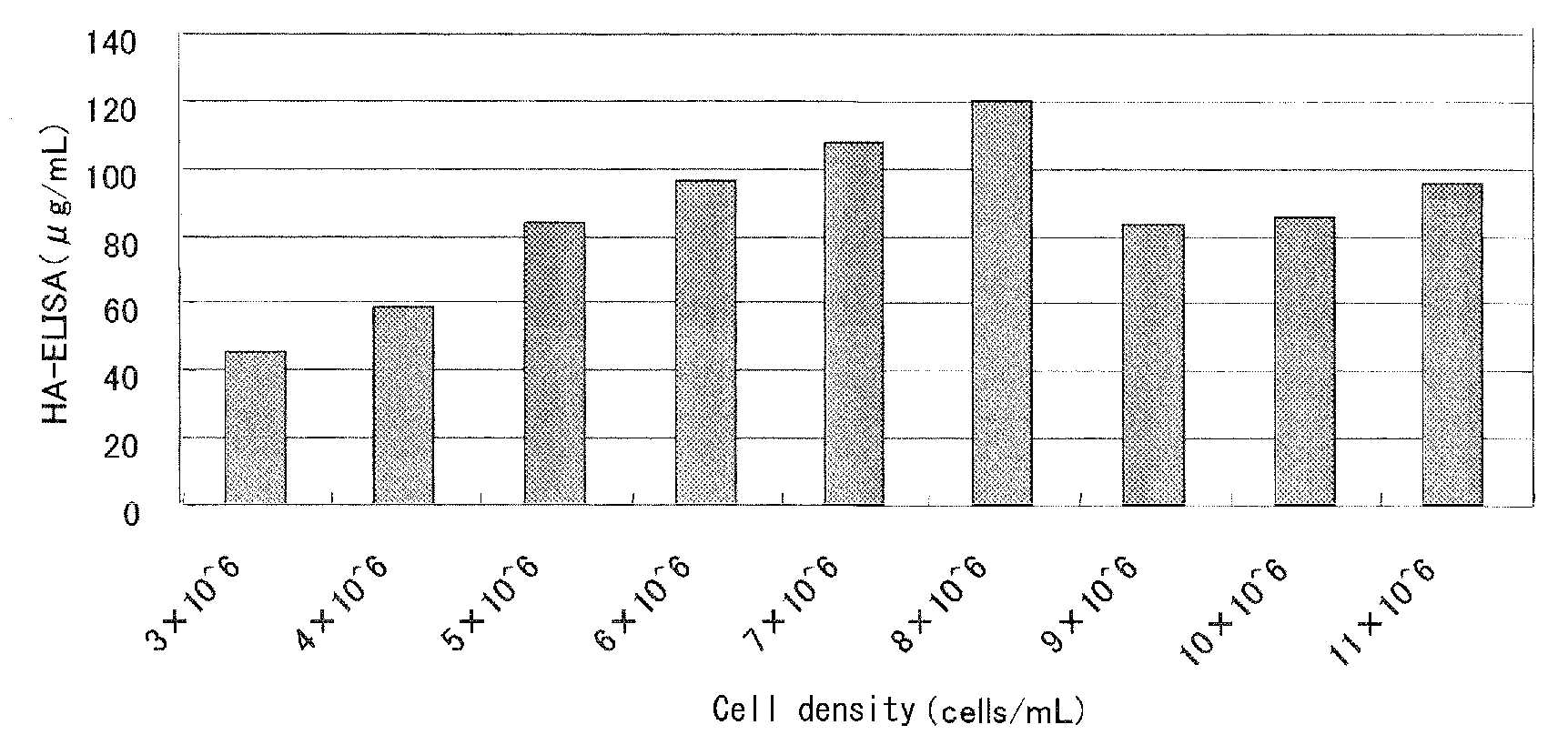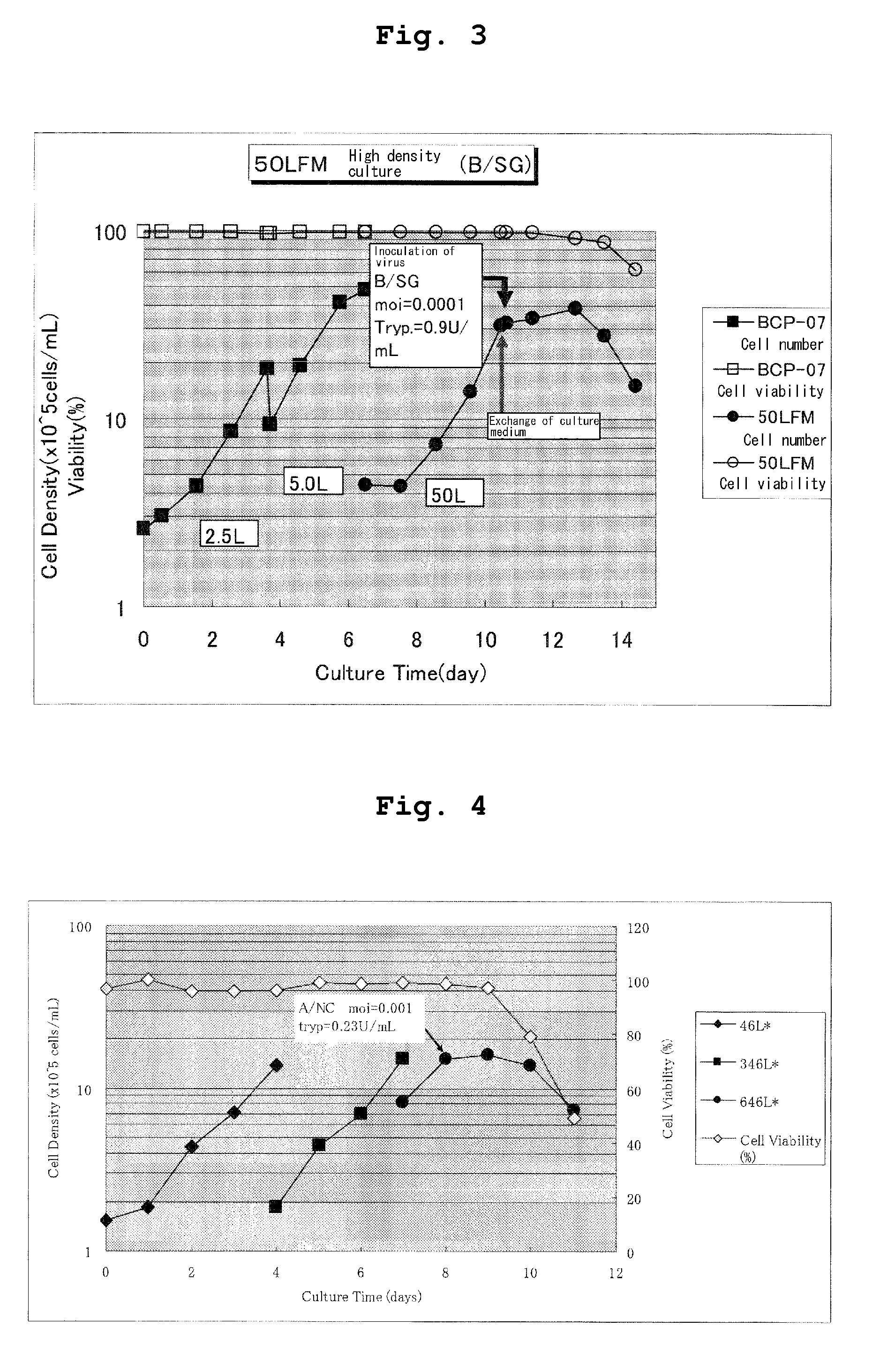Method for propagating influenza virus
a technology for propagating influenza virus and circulating in the field of influenza virus propagation, which can be applied in the direction of viruses/bacteriophages, artificial cell constructs, antibody medical ingredients, etc., to achieve the effect of reducing the amount of viral solution and increasing the production of influenza virus
- Summary
- Abstract
- Description
- Claims
- Application Information
AI Technical Summary
Benefits of technology
Problems solved by technology
Method used
Image
Examples
example 1
Effect of Trypsin Concentration on High Density Culture of Influenza Virus
(1) High Density Culture of A / New Caledonia Strain
[0034]Dog kidney cells (MDCK) after suspension culture in T7m medium (JRH) were centrifuged at a low speed (2000 rpm×3 min.) and were suspended in 50 mL of fresh T7m medium at an initial cell density of 3.16×106 cells / mL. Thereto were added influenza virus A / New Caledonia strain (m.o.i. 0.001) and trypsin (DIFCO, Trypsin 250) at various concentrations and the cells were cultured with a 250 mL shaker flask under culture conditions of 100 rpm, 34° C., 5% CO2. A viral amount was measured by ELISA using an anti-HA antibody. Namely, each 100 μL of the culture solution was added to a 98-well ELISA plate (Nunc) coated with a solution of an anti-HA antibody and the plate was left to stand at 37° C. for 1 hour. After washing with PBS, 100 μL of an anti-HA antibody labeled with HRP was added to the plate for reaction at 37° C. for 1 hour. Then, 100 μL of a developing sol...
example 2
Effect of Rate of Culture Exchange on High Density Culture of A / New Caledonia Strain
[0036]MDCK cells after suspension culture in T7m medium (JRH) were centrifuged at a low speed (2000 rpm×3 min.) to separate precipitated cells from culture supernatant. The culture supernatant was adequately mixed with a fresh T7m medium and the mixture was added to the precipitated cells to prepare a solution of cell suspension at an initial cell density of 4.21×106 cells / mL. To 50 mL of this solution of cell suspension was added a trypsin solution at a final concentration of 1.8 Tryp.U / mL. The conditions in Example 1-(1) were used to culture virus-infected cells and a viral amount in culture was measured. The results are shown in Table 3. At 75% exchange of fresh T7m culture, a viral amount reached a plateau and, at a higher rate of culture exchange, remained at the same level. In the table, the viral amount is shown in μg / mL and ND means no measurement.
TABLE 3Days ofRate of culture exchangeculture...
example 3
Effect of Cell Density on High Density Culture of A / New Caledonia Strain
[0037]MDCK cells after suspension culture in T7m medium (JRH) were centrifuged at a low speed (2000 rpm×3 min.) and precipitated cells were suspended in 50 mL of a fresh T7m medium at an initial cell density of 3-11×106 cells / mL. To the suspension were added influenza virus A / New Caledonia strain (m.o.i. 0.001) and 1.8 Tryp.U / mL of trypsin (DIFCO, Trypsin 250) for culture. Culture was carried out under the same conditions as in Example 1-(1). As a result, a viral amount in culture increased depending on a cell concentration within a range of a cell density of 3-7×106 cells / mL and thereafter reached a plateau (FIG. 1).
PUM
| Property | Measurement | Unit |
|---|---|---|
| Volume | aaaaa | aaaaa |
| Volume | aaaaa | aaaaa |
| Volume | aaaaa | aaaaa |
Abstract
Description
Claims
Application Information
 Login to View More
Login to View More - R&D
- Intellectual Property
- Life Sciences
- Materials
- Tech Scout
- Unparalleled Data Quality
- Higher Quality Content
- 60% Fewer Hallucinations
Browse by: Latest US Patents, China's latest patents, Technical Efficacy Thesaurus, Application Domain, Technology Topic, Popular Technical Reports.
© 2025 PatSnap. All rights reserved.Legal|Privacy policy|Modern Slavery Act Transparency Statement|Sitemap|About US| Contact US: help@patsnap.com



